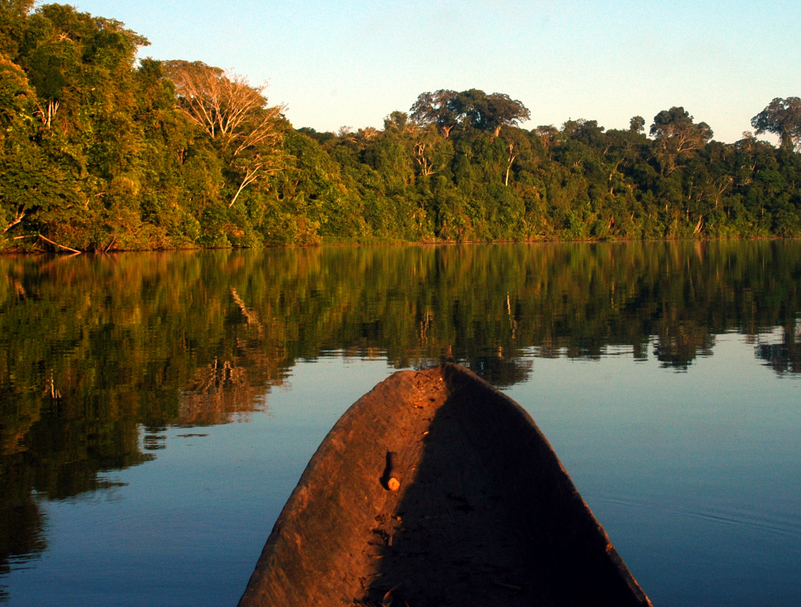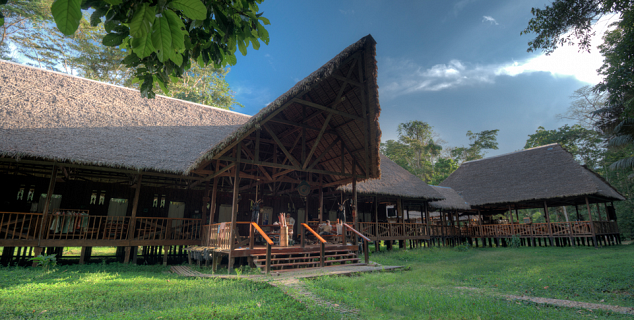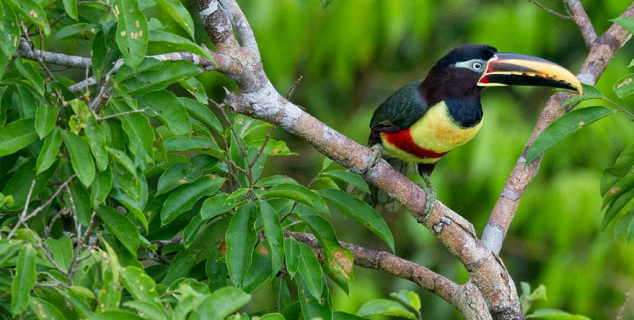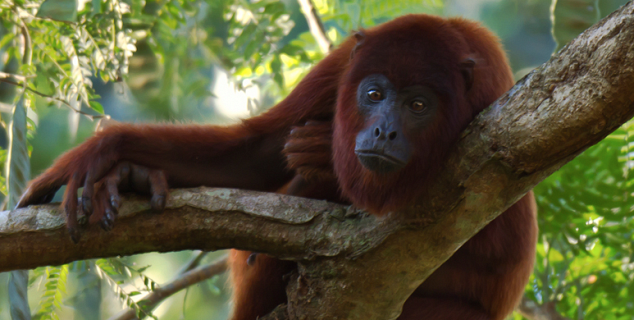Call us now:
0333 7000 747
Open 9 until 9 daily
Start your perfect holiday
contact us today!
Inclusive Package with flights
- Amazon Basin
- Arequipa & Canyon Country
- Central Highlands
- Cusco & Machu Picchu
- Huaraz & The Cordilleras
- Lake Titicaca
- Lima
- North Coast
- Northern Highlands
- South Coast
Holiday Confusion?
You need a Specialist
Ask us about Tambopata
Request a Quote Today!
Tambopata Research Centre
Tambopata Research Center jungle lodge is only accessible by boat, a journey of several hours up the Tambopata River, leaving the final traces of human habitation far behind.
Tambopata offers a comfortable 18-bedroom lodge which was built more than twenty years ago (rebuilt only in 2011) offering accommodation for tourists and researchers alike and protecting the adjacent macaw clay lick.
Within the 700,000 hectare uninhabited nucleus of the reserve, wildlife sightings are frequent and can be compelling.
What’s so Special?
Home to several newly discovered species, Tambopata Research Center (TRC) is the most remote rainforest lodge in the Amazon, and offers adventurous travellers an outstanding chance to engage with the natural wonders of the Amazon.
Tambopata’s isolation within the uninhabited and pristine heart of the reserve means that sightings of monkeys, macaws and other large species are more frequent. Jaguars are even sometimes seen near the river bank!
Bear in Mind
It’s a journey! But like all the best ones, it’s worth the effort.
Day 1: Fly to Puerto Maldonado
You will be collected from your hotel in Cusco or Lima and transferred to the airport for your flight to Puerto Madonado.
From the airport it’s a 10-minute drive to Puerto Maldonado headquarters for the boat transfer into the Rainforest.
There is a weight restriction, so it is important to pack only the gear you will need for the next few days.
Remaining luggage will be safely stored at the lodge HQ in Puerto Maldonado.
From here it’s a 20 km drive to Tambopata River Port, entering the Native Community of Infierno before boarding the boat to Refugio Amazonas, which is a 2.5-hour journey.
A boxed lunch will be provided and on arrival, the lodge manager will welcome you and brief you with important navigation and security tips.
After dinner at the lodge, head out on a boat trip in search of Caiman.
The boat will cruise close to the river’s edge, scanning the shores with headlamps and flashlights to catch the red gleams of reflection from caiman eyes.
Overnight at Refugio Amazonas. All meals and activities included.
Day 2: Tambopata Research Center
A thirty-minute walk from Refugio Amazonas leads to the 25-metre scaffolding canopy tower, where a staircase running through the middle provides safe access to the platforms above.
The tower has been built on high ground, increasing the horizon of the continuous primary forest extending out towards the Tambopata National Reserve.
From here views of mixed species flocks over the canopy as well as toucans, macaws and raptors are likely.
After breakfast head deeper into the Amazon (4.5 hours) to Tambopata Research Centre (TRC).
One and a half hours into the boat journey, cross the confluence with the Malinowski River and leave the final traces of human habitation behind.
Within the 700,000 hectare uninhabited nucleus of the reserve, sightings of capybara, caiman, geese, macaws and other large species become more frequent.
Three hours from Refugio Amazonas, deep in the Tambopata National Reserve stop at the Chuncho clay lick.
It’s a 5 minutes to the clay lick there is the chance to see dozens of large macaws feeding on the special sodium rich clays of the riverbank.
The Chuncho clay lick probably attracts more large macaws than any other claylick in the world and the sight of dozens of macaws taking flight is truly unforgettable.
This stop will depend on the weather and the amount of macaw activity, as the birds don’t visit the clay lick when it’s raining.
On arrival, the lodge manager will welcome you and brief you with important navigation and security tips.
A 3–5 km hike leads to an outlook commanding magnificent views of the Tambopata winding its way into the lowlands.
The forest on this trail, regenerating on old bamboo forest, is great for observing Howler and Dusky Titi Monkeys.
After dinner at the lodge, a scientist will provide an in-depth look at the biology of macaws, their feeding habits, the theories for clay lick use, their breeding and feeding ecology, population fluctuations and the threats to their conservation.
Overnight Tambopata Research Center. All meals and activities included.
Day 3: Tambopata Research Center
On most clear mornings of the year dozens of large macaws and hundreds of parrots congregate on this large river bank in a raucous and colorful spectacle which inspired a National Geographic cover story.
Discretely located fifty meters from the cliff, observe Green-winged, Scarlet and Blue-and-gold Macaws and several species of smaller parrots descend to ingest clay.
Outings are at dawn when the lick is most active. After breakfast back at the lodge head out on the Floodplain Trail, a 5 km trail through prototypical Rainforest with immense trees criss-crossed by creeks and ponds.
Amongst the figs, ceibas and shihuahuacos search for Squirrel, Brown Capuchin, and Spider Monkeys as well as peccaries.
After lunch head to Pond Platform ten minutes upriver from the lodge - a tiny pond with a platform in the middle.
This is a great place to spot waterfowl such as Muscovy duck, sunbittern and hoatzin along with the woodpeckers, oropendolas, flycatchers and parakeets that call this pond their home.
After dinner there is the option of hiking out at night, when most of the mammals are active but rarely seen.
Much easier to find are frogs with shapes and sounds as bizarre as their natural histories.
Overnight Tambopata Research Center. All meals and activities included.
Day 4: Tambopata Research Center – Puerto Maldonado
After breakfast, transfer by boat back to Puerto Maldonado HQ and on to the airport for your onward flight to Cusco or Lima.
Remember that all of our tours are completely tailor made and we can adjust this itinerary to entirely suit your interests and schedule.
Day 1: Fly to Puerto Maldonado
You will be collected from your hotel in Cusco or Lima and transferred to the airport for your flight to Puerto Madonado.
From the airport it’s a 10-minute drive to Puerto Maldonado headquarters for the boat transfer into the Rainforest.
There is a weight restriction, so it is important to pack only the gear you will need for the next few days.
Remaining luggage will be safely stored at the lodge HQ in Puerto Maldonado.
From here it’s a 20 km drive to Tambopata River Port, entering the Native Community of Infierno before boarding the boat to Refugio Amazonas, which is a 2.5-hour journey.
A boxed lunch will be provided and on arrival, the lodge manager will welcome you and brief you with important navigation and security tips.
After dinner at the lodge, head out on a boat trip in search of Caiman.
The boat will cruise close to the river’s edge, scanning the shores with headlamps and flashlights to catch the red gleams of reflection from caiman eyes.
Overnight at Refugio Amazonas. All meals and activities included.
Day 2: Tambopata Research Center
A thirty-minute walk from Refugio Amazonas leads to the 25-metre scaffolding canopy tower, where a staircase running through the middle provides safe access to the platforms above.
The tower has been built on high ground, increasing the horizon of the continuous primary forest extending out towards the Tambopata National Reserve.
From here views of mixed species flocks over the canopy as well as toucans, macaws and raptors are likely.
After breakfast head deeper into the Amazon (4.5 hours) to Tambopata Research Centre (TRC).
One and a half hours into the boat journey, cross the confluence with the Malinowski River and leave the final traces of human habitation behind.
Within the 700,000 hectare uninhabited nucleus of the reserve, sightings of capybara, caiman, geese, macaws and other large species become more frequent.
Three hours from Refugio Amazonas, deep in the Tambopata National Reserve stop at the Chuncho claylick.
It’s a 5 minutes to the clay lick there is the chance to see dozens of large macaws feeding on the special sodium rich clays of the riverbank.
The Chuncho clay lick probably attracts more large macaws than any other claylick in the world and the sight of dozens of macaws taking flight is truly unforgettable.
This stop will depend on the weather and the amount of macaw activity, as the birds don’t visit the clay lick when it’s raining.
On arrival, the lodge manager will welcome you and brief you with important navigation and security tips.
A 3–5 km hike leads to an outlook commanding magnificent views of the Tambopata winding its way into the lowlands.
The forest on this trail, regenerating on old bamboo forest, is great for observing Howler and Dusky Titi Monkeys.
After dinner at the lodge, a scientist will provide an in-depth look at the biology of macaws, their feeding habits, the theories for clay lick use, their breeding and feeding ecology, population fluctuations and the threats to their conservation.
Overnight Tambopata Research Center. All meals and activities included.
Day 3: Tambopata Research Center
On most clear mornings of the year dozens of large macaws and hundreds of parrots congregate on this large river bank in a raucous and colorful spectacle which inspired a National Geographic cover story.
Discretely located fifty meters from the cliff, observe Green-winged, Scarlet and Blue-and-gold Macaws and several species of smaller parrots descend to ingest clay.
Outings are at dawn when the lick is most active. After breakfast back at the lodge head out on the Floodplain Trail, a 5 km trail through prototypical Rainforest with immense trees criss-crossed by creeks and ponds.
Amongst the figs, ceibas and shihuahuacos search for Squirrel, Brown Capuchin, and Spider Monkeys as well as peccaries.
After lunch head to Pond Platform ten minutes upriver from the lodge - a tiny pond with a platform in the middle.
This is a great place to spot waterfowl such as Muscovy duck, sunbittern and hoatzin along with the woodpeckers, oropendolas, flycatchers and parakeets that call this pond their home.
After dinner there is the option of hiking out at night, when most of the mammals are active but rarely seen.
Much easier to find are frogs with shapes and sounds as bizarre as their natural histories.
Overnight Tambopata Research Center. All meals and activities included.
Day 4: Tambopata Research Center
Visit the clay lick again this morning before breakfast.
After breakfast visit an entirely different habitat characterized by smaller, thinner trees atop hills and slopes on a 5 km walking trail.
Saddleback tamarins are frequently found here and rare tapir tracks may be spotted.
After lunch, depart on the Palm Swamp Trail.
Growing on the remains of an oxbow lake and providing both arboreal as well as terrestrial mammals with fruits throughout the year, the aguaje palms are one of the most important food sources in the rainforest.
Demand for these fruits and great conditions for planting rice, make the palm swamp one of the most threatened habitats in the Amazon.
Overnight Tambopata Research Center. All meals and activities included.
Day 5: Tambopata Research Center – Puerto Maldonado
After breakfast, transfer by boat back to Puerto Maldonado HQ and on to the airport for your onward flight to Cusco or Lima.
Remember that all of our tours are completely tailor made and we can adjust this itinerary to entirely suit your interests and schedule.
Day 1: Fly to Puerto Maldonado
You will be collected from your hotel in Cusco or Lima and transferred to the airport for your flight to Puerto Madonado.
From the airport it’s a 10-minute drive to Puerto Maldonado headquarters for the boat transfer into the Rainforest.
There is a weight restriction, so it is important to pack only the gear you will need for the next few days.
Remaining luggage will be safely stored at the lodge HQ in Puerto Maldonado.
From here it’s a 20 km drive to Tambopata River Port, entering the Native Community of Infierno before boarding the boat to Refugio Amazonas, which is a 2.5-hour journey.
A boxed lunch will be provided and on arrival, the lodge manager will welcome you and brief you with important navigation and security tips.
After dinner at the lodge, head out on a boat trip in search of Caiman.
The boat will cruise close to the river’s edge, scanning the shores with headlamps and flashlights to catch the red gleams of reflection from caiman eyes.
Overnight at Refugio Amazonas. All meals and activities included.
Day 2: Tambopata Research Center
A thirty-minute walk from Refugio Amazonas leads to the 25-metre scaffolding canopy tower, where a staircase running through the middle provides safe access to the platforms above.
The tower has been built on high ground, increasing the horizon of the continuous primary forest extending out towards the Tambopata National Reserve.
From here views of mixed species flocks over the canopy as well as toucans, macaws and raptors are likely.
After breakfast head deeper into the Amazon (4.5 hours) to Tambopata Research Centre (TRC).
One and a half hours into the boat journey, cross the confluence with the Malinowski River and leave the final traces of human habitation behind.
Within the 700,000 hectare uninhabited nucleus of the reserve, sightings of capybara, caiman, geese, macaws and other large species become more frequent.
Three hours from Refugio Amazonas, deep in the Tambopata National Reserve stop at the Chuncho claylick.
It’s a 5 minutes to the clay lick there is the chance to see dozens of large macaws feeding on the special sodium rich clays of the riverbank.
The Chuncho clay lick probably attracts more large macaws than any other claylick in the world and the sight of dozens of macaws taking flight is truly unforgettable.
This stop will depend on the weather and the amount of macaw activity, as the birds don’t visit the clay lick when it’s raining.
On arrival, the lodge manager will welcome you and brief you with important navigation and security tips.
A 3–5 km hike leads to an outlook commanding magnificent views of the Tambopata winding its way into the lowlands.
The forest on this trail, regenerating on old bamboo forest, is great for observing Howler and Dusky Titi Monkeys.
After dinner at the lodge, a scientist will provide an in-depth look at the biology of macaws, their feeding habits, the theories for clay lick use, their breeding and feeding ecology, population fluctuations and the threats to their conservation.
Overnight Tambopata Research Center. All meals and activities included.
Day 3: Tambopata Research Center
On most clear mornings of the year dozens of large macaws and hundreds of parrots congregate on this large river bank in a raucous and colorful spectacle which inspired a National Geographic cover story.
Discretely located fifty meters from the cliff, observe Green-winged, Scarlet and Blue-and-gold Macaws and several species of smaller parrots descend to ingest clay.
Outings are at dawn when the lick is most active. After breakfast back at the lodge head out on the Floodplain Trail, a 5 km trail through prototypical Rainforest with immense trees criss-crossed by creeks and ponds.
Amongst the figs, ceibas and shihuahuacos search for Squirrel, Brown Capuchin, and Spider Monkeys as well as peccaries.
After lunch head to Pond Platform ten minutes upriver from the lodge - a tiny pond with a platform in the middle.
This is a great place to spot waterfowl such as Muscovy duck, sunbittern and hoatzin along with the woodpeckers, oropendolas, flycatchers and parakeets that call this pond their home.
After dinner there is the option of hiking out at night, when most of the mammals are active but rarely seen.
Much easier to find are frogs with shapes and sounds as bizarre as their natural histories.
Overnight Tambopata Research Center. All meals and activities included.
Day 4: Tambopata Research Center
Visit the clay lick again this morning before breakfast.
After breakfast visit an entirely different habitat characterized by smaller, thinner trees atop hills and slopes on a 5 km walking trail.
Saddleback tamarins are frequently found here and rare tapir tracks may be spotted.
After lunch, depart on the Palm Swamp Trail.
Growing on the remains of an oxbow lake and providing both arboreal as well as terrestrial mammals with fruits throughout the year, the aguaje palms are one of the most important food sources in the rainforest.
Demand for these fruits and great conditions for planting rice, make the palm swamp one of the most threatened habitats in the Amazon.
Overnight Tambopata Research Center. All meals and activities included.
Day 5: Tambopata Research Center
Head out again this morning on the Overlook Trail from the second day, with another chance to observe wildlife, especially monkeys.
In the afternoon visit Creeks Trail with its Terra Firme forest, crossed by a number of creeks that eventually reach the Tambopata River.
Walking in the opposite direction to the river, this walk focuses on forest and creek ecology.
Overnight Tambopata Research Center. All meals and activities included.
Day 6: Tambopata Research Center – Puerto Maldonado
After breakfast, transfer by boat back to Puerto Maldonado HQ and on to the airport for your onward flight to Cusco or Lima.
Remember that all of our tours are completely tailor made and we can adjust this itinerary to entirely suit your interests and schedule.
Day 1: Fly to Puerto Maldonado
You will be collected from your hotel in Cusco or Lima and transferred to the airport for your flight to Puerto Madonado.
From the airport it’s a 10-minute drive to Puerto Maldonado headquarters for the boat transfer into the Rainforest.
There is a weight restriction, so it is important to pack only the gear you will need for the next few days.
Remaining luggage will be safely stored at the lodge HQ in Puerto Maldonado.
From Puerto Maldonado drive to the Tambopata River Port. This forty five minute drive will take twice as long as there will be stops along the road’s secondary forest to scan for Purus Jacamar, White browed Blackbird, Pearl Kite, and Scaled Pigeon.
A private boat with individual seats and a roof will journey upriver to Posada Amazonas.
Lunch will be taken on the boat, with as many stops as required on the hour long drive to search for Pied Lapwing, Collared Plover, King Vulture, Bat Falcon, Olive and Russet-backed Oropendolas and Ringed Kingfisher and Amazon Kingfisher.
A boxed lunch will be provided and on arrival, the lodge manager will welcome you and brief you with important navigation and security tips.
The rest of the day is free at leisure.
Overnight Posada Amazonas. All meals and activities included.
Day 2: Tambopata Research Center
A thirty-minute walk from Posada Amazonas leads to the 30-metre scaffolding canopy tower, which adds a whole new dimension to this Amazon birding experience.
Wait for a canopy mixed flock to appear. The mixed flock is mostly all about tanagers: Paradise Tanager, Green-and-gold Tanager, Flame-crested Tanager, Turqoise Tanager, Opal- rumped Tanager and others.
The tower also offers good opportunities to see Cream-coloured Woodpecker, Gilded Barbet, Plum-throated Cotinga and Striolated Puffbird.
Macaws and toucans are usually seen flying against the horizon, including the Chestnut-eared, Lettered, Emerald, Curl-crested, and Brown-mandibled Aracaries.
Lonely raptors are usally seen riding the thermals. This is also your best chance for hawk-eagles and even harpy!
After lunch go birding along the Shahue Trail, good for Fiery-capped Manakin, Round-tailed Manakin, Pale Rumped Trumpeteer and Pavonine Quetzal.
Overnight Posada Amazonas. All meals and activities included.
Day 3: Tambopata Research Center
Today journey deeper into the Amazon with great birding en-route.
Tres Chimbadas is thirty minutes by boat and forty five minutes hiking from Posada Amazonas.
Once there, paddle around the lake in a catamaran, searching for the resident family of nine giant river otters (seen by 60% of lake visitors) and other lakeside wildlife such as caiman, hoatzin and horned screamers.
Otters are most active from dawn to eight or nine AM.
From here it's a fifteen minute drive to the bamboo patches around Tres Chimbadas Lake.
Leave lake birding aside and focus on the bamboo specialists such as the endemic White-cheeked Tody Tyrant, Peruvian Recurvebill, Red-billed Scythebill, Rufous-headed Woodpecker, Rufous-breasted Piculet, Brown-rumped Foliage Gleaner, Large- headed Flatbill, Dusky-tailed Flatbill, Dusky-cheeked Foliage-gleaner, Flammulated Bamboo-tyrant, Dot-winged and Ornate Antwren, White-lined Antbird, Rufous capped Nunlet, Pheasant Cuckoo and Striped Cuckoo.
In the afternoon, transfer on to Tambopata Research Centre.
During the first three hours of the boat ride, on entering the Tambopata National Reserve, focus on recapping and listing.
Then the fun begins and it lasts for three more hours!
Numerous egrets, Capped heron, Cocoi Heron, Large and Yellow-billed Tern, Black Skimmer, the classic Horned Screamer, Razor Billed Currasow, Blue-throated Piping Guan and Orinoco Goose and during the dry season months, migrant shorebirds, are all possibilities for this portion of the trip.
Every now and then macaws, toucans and raptors will be spotted above.
Three hours from Refugio Amazonas, deep in the Tambopata National Reserve stop at the Chuncho clay lick.
It’s a 5 minutes to the clay lick there is the chance to see dozens of large macaws feeding on the special sodium rich clays of the riverbank.
The Chuncho clay lick probably attracts more large macaws than any other claylick in the world and the sight of dozens of macaws taking flight is truly unforgettable.
Overnight Tambopata Research Center. All meals and activities included.
Day 4: Tambopata Research Center
On most clear mornings of the year dozens of large macaws and hundreds of parrots congregate on this large river bank just across the river.
Expect to see ten to twelve of the following members of the parrot family: Red-and-green, Blue-and-gold, Scarlet, Red-bellied, Chestnut-fronted and Blue-headed Macaws; Mealy and Yellow-crowned Amazons; Blue-headed, Orange-cheeked and White-bellied Parrots; Dusky-headed, White-eyed, Cobalt-winged and Tui Parakeets and Dusky-billed Parrotlets.
Discretely located fifty meters from the cliff, observe Green-winged, Scarlet and Blue-and-gold Macaws and several species of smaller parrots descend to ingest clay.
After lunch explore quintessential rainforest on the 5 mile Ocelot Trail and the 5 mile Toucan Trail systems.
The Ocelot Trail is in the floodplain with ponds and streams forming during the rainy season.
The Toucan Trail on the other hand is tall rainforest that rarely or never floods.
Both of these trails represent the most speciose habitats for birds.
Too many possibilities to list, this is habitat for Starred Wood Quail, Pale-winged Trumpeter, several Trogons, Foliage-gleaners, Black-tailed Leaftosser, many Woodcreepers, Antbirds, Flycatchers, Manakins, and much more.
Mixed species flocks are especially diverse with understory flocks led by Dusky-throated Antshrike and Red-crowned Ant-Tanagers.
They often contain 30-40 species (or more!) including: Plain winged Antshrike, Bluish Slate Antshrike, White eyed Antwren, Plain breasted Antwren, Thrush-like Antpitta, White winged Shrike Tanager, Amazonian Barred Woodcreeper and Spix’s Woodcreeper.The Ocelot trail also crosses some permanently flooded old ponds inhabited by Agami Heron, Rufescent Tiger-heron, Pygmy and Green-and-rufous Kingfishers, and Sunbittern.
After these fairly long hikes and lunch continue birding if you wish within the confines of TRC. Species possible on the TRC clearing include: eventual canopy flocks, Squirrel Cuckoo, Masked Crimson Tanager, Cinammon- throated Woodcreeper, Speckled Chachalaca and Yellow-tufted Woodpecker.
Overnight Tambopata Research Center. All meals and activities included.
Day 5: Tambopata Research Center
Enjoy a second visit to Floodplain and Terra Firme Forest
After breakfast, venture back into the beautiful rainforests at TRC.
Literally hundreds of bird species live in these forests and a different set of birds is often seen on the same trails from the previous day.
Search for antswarms attended by such exciting species as Black-spotted Bare Eye, Black-banded Woodcreeper, Sooty Antbird, and maybe even a Rufous-vented Ground Cuckoo, and keep an eye and ear out for uncommon ground birds like tinamous, Striated Antthrush and Razor-billed Curassow.
Also look for such targets as the stunning Pavonine Quetzal, Black-bellied Cuckoo, Amazonian Pygmy Owl, Great Jacamar, Ringed Antpipit, Casque-headed Oropendola, Speckled Spinetail, big mixed flocks led by White-winged Shrike Tanager and many other species.
Rare surprises such as Crested or Harpy Eagle, forest falcons, and Yellow-bellied Tanager are also possible in these exciting rainforests.
After lunch, enjoy birding in the transitional forests above the clay lick.
These were bamboo forests until they flowered and died out a few years ago.
Now they are akin to riparian forests but will eventually grow into terra firme as they are not affected by yearly floods.
Here spot White-throated Jacamar, Buff-throated Saltator, Grayish Saltator, Scarlet-hooded Barbet, Crested and Russet-backed Oropendolas, Piratic Flycatatcher, Yellow-billed Nunbird and others.
While birding these spots enjoy extraordinary views of the Tambopata winding its way from the highlands.
Overnight Tambopata Research Center. All meals and activities included.
Day 6: Tambopata Research Center
Today explore older river created habitats at the pond five minutes upstream from TRC – forests of Cecropia and Balsa Wood with a bamboo understory.
This is the habitat of the legendary Rufous-fronted Anthrush, and the Lemon-throated Barbet, Spot-breasted Woodpecker, Cabanis Spinetail, Amazonian Antpitta, Blackish Antbird, Fuscous Flycatcher, Guira Tanager and Troupial.
On exiting the pond’s forests, bird on grassy areas with Tessaria and young Cecropia trees.
These are not very diverse for birds but are the main habitat for Plain-crowned and Dark-breasted Spinetails, Mottle-backed Elaenia, Spotted Tody-Flycatcher, Black-billed Thrush, Orange-headed Tanager, and Seedeater species among others.
After lunch, it's a 30-minute hike from TRC in the Terra Firme forest to a 17-metre scaffolding canopy tower.
From the top there are spectacular views of the vast expanses of standing forest.
Toucans, parrots and macaws can be seen flying against the horizon.
Flocks of mixed species of birds can also be seen flying and landing in the treetops next to you.
After dinner, venture out near the lodge to spot-light Pauraque, Tawny-bellied Screech-Owl, Great Potoo, Long tailed Potoo, Ocellated Poorwill and with luck a Mottled Owl or Crested Owl.
There is also the possibility of taking macro-shots of American Bullfrogs, Horned Frog, tree frogs and other creatures of the night.
Overnight Tambopata Research Center. All meals and activities included.
Day 7: Refugio Amazonas
After breakfast take a three and a half hour boat ride to Refugio Amazonas, with a packed lunch on the way.
A thirty-minute walk from Refugio Amazonas leads to the 25-metre scaffolding canopy tower, where a staircase running through the middle provides safe access to the platforms above.
The tower has been built on high ground, increasing the horizon of the continuous primary forest extending out towards the Tambopata National Reserve.
From here views of mixed species flocks over the canopy as well as toucans, macaws and raptors are likely.
Overnight Refugio Amazonas. All meals and activities included.
Day 8: Refugio Amazonas
Take a 2 km trail along the Tambopata River, where diversity is guaranteed as the trail crosses both Terra Firme Forest and Secondary Forest.
Look for black fronted nunbird, bluish fronted jacamar, fiery capped manakin, gray crowned flycatcher and yellow-browed tody-flycatcher, among several other species.
Since Refugio Amazonas is built on land which was once part of a timber concession and cattle ranch the forest on parts of the trail system are secondary.
This means this afternoon's focus is on: Barred Antshrike, Short-tailed Pygmy Tyrant, Streaked Flycatcher, Boat-billed Flycatcher, Solitary Black Cacique, Gray-fronted Dove, Ruddy Ground Dove and others.
Overnight Refugio Amazonas. All meals and activities included.
Day 9: Refugio Amazonas - Puerto Maldonado - Cusco/Lima
After breakfast, transfer by boat back to Puerto Maldonado HQ and on to the airport for your onward flight to Cusco or Lima.
Remember that all of our tours are completely tailor made and we can adjust this itinerary to entirely suit your interests and schedule.
Includes:
- Domestic flights from Cusco or Lima
- All taxes
- Accommodation in Traditional Double Room
- All meals
- Boat and road transfers
- All activities mentioned in the itinerary
Not included:
- Alcoholic drinks & bottled water
- Insurance
- Personal expenses and tips
4 Day Package - from £914 pp
5 Day Package - from £1,070 pp
6 Day Package - from £1,139 pp
9 Days Birding Package - from £2,325 pp
This is a guide price only, based on travel in low season.
Prices will vary according to availability of airfares on the dates of travel and seasonal hotel and airfare surcharges.
Please ask us for any current special offers.
Contact Us:
All of our Peru Holidays are completely tailor made and we can put together any kind of itinerary to suit your interests and budget.
Call us now to speak to a Peru holiday expert about your Peru holiday or honeymoon to Peru.
Call us now on 0333 7000 747
Please indicate your preferred package:
We're open from 9 until 9 daily and our 0333 number is a local rate number included in most call packages.















